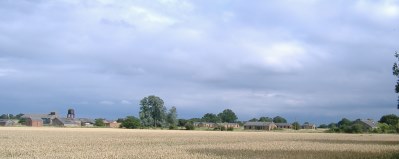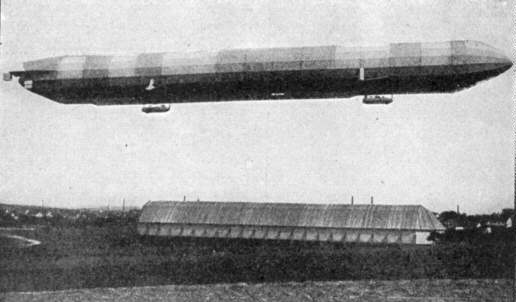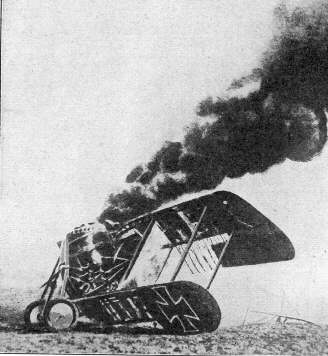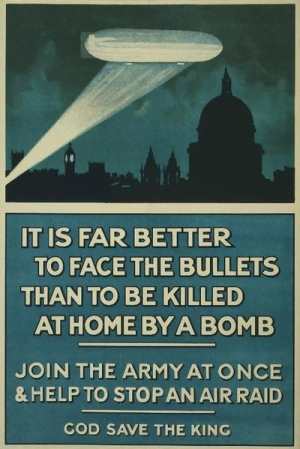Dengie Hundred in World War One
War in the air
The main threat to the British Mainland was from Zeppelin raiders who used the River Thames, Crouch and Blackwater as navigational aids on reaching the coast.
To combat this risk two airfields were established within the Dengie 100 to guard against Zeppelins.
Burnham on Crouch
Burnham airfield was established as a night flight station in 1915 at Wick Road an land adjoining Wick Farm.
Initially the airfield was used by RNAS but in 1916 the airfield was taken over the RFC who extended the site.
Click here to view pages with more detail on Burnham's WW1 airfield
Stow Maries
 Stow
Maries airfield as it appears today
Stow
Maries airfield as it appears today
Stow Maries airfield was established in 1916 when the BE 12sB flight of no 37( Home Defence) Squadron moved in from their base at Suffolk.
By late 1919 the need for air defence had lowered and the use of the airfield was discontinued.
The airfield reverted to farming although the buildings and runways were left intact.
Air Defences
The Crouch Valley line became a vital network to bring material and men to the Dengie 100 to deal with the threat of German invasion and the Zeppelin raids.
 zeppelin
picture courtesy of www.gwpda.org
zeppelin
picture courtesy of www.gwpda.org
On 16 April 1915 Zeppelin raids took place in Eastern Essex with two Zeppelins flying over Burnham on Crouch before dropping 25 bombs on Maldon and Tillingham. Little damage was done although the local newspaper reported the deaths of three chickens! . The raids did however scare the residents of the area who took cover when Zeppelins were sighted rather than stare at the spectacle.
Southminster railway yards became the marshalling centre for troop trains requiring the services of an Army Major to control.
By the end of 1914 there were 15 anti aircraft emplacements in the Dengie 100 mostly sited in Southminster marshes.
Higher land at Beacon Hill and East Newlands farm , St Lawrence proved higher ground for anti aircraft guns to deal with Zeppelins and Gotha bombers following the path of the nearby River Blackwater.
These guns were called into use on several occasions but no direct hits are recorded.
The main anti aircraft battery in Burnham was sited in Riverside Road with the Officers in charge billeted in nearby Warners Hall
One success was the shooting down of a German
Gotha near the mouth of the Crouch.
 picture
courtesy of www.gwpda.org
picture
courtesy of www.gwpda.org
The Burnham Anti aircraft battery was kept busy in 1917 as the Germans developed the Gotha Bomber that as capable of flying at higher altitudes that the British fighters and had the range to reach London and return to German held airfields. Geography dictated that the Crouch and Blackwater rivers made a perfect route for the bombers to follow en route to Burnham and as many a 20 Gotha bombers were seen flying over Eastern Essex
Osea Island
In 1913 Osea Island was enveloped in tight security whilst a Royal Navy team led by Lt Porte conducted tests on a revolutionary new two man Seaplane called throe Seagull which was intended to be the main line of defence against enemy submarines and Zeppelins.
Sadly during the trials the Seagull did not prove successful and was not taken into the intended mass use by RNAS.
By 1917 Osea island in the River Blackwater was a base for Coastal Torpedo Patrol boats which were lively small craft prominent in the English Channel and river estuaries often used as submarine chasers.
Workshop facilties for service and docking stages for up to 50 Patrol boats were constructed but as the first patrol boats arrived in early 1918 the strength did not reach the capacity envisaged.
St Lawrence Bay
The life in the small village of St Lawrence was affected by the Great War.
The ' Warwicks' were quartered in the village to provide security on the Southern banks of the River Blackwater.
The Rectory provided quarter for the Officers.
Patrols often stopped pedestrian or cars for identity checks as fears were high that German spies may be in the area.
They fortified the village by the erection of barbed wire defences and dugouts / trenches at locations on the riverside.
Submarine miners mined the river and built a control station to the east of the wharf.
By 1917 the need for coastal defences had diminished and the troops were withdrawn and defences demolished.
The war at sea
Given the coastal nature of this area and the navigable estuaries of the River Blackwater and the River Crouch the area played an important role in the sea war especially for smaller vessels.
The Crouch and the Blackwater were considered vulnerable and as such were mined to prevent German shipping entering the river.
Pleasure crafts on the Crouch and Blackwater were resticted to small areas of the river and not allowed to sail between 8pm and 6am. All had to be registered with the Police and display their registration numbers.
Sailing barges and local traders were allowed to enter the Blackwater via the wallet channel and the Crouch via the swim channel but they had to register with the customs, fly a Red Ensign and be at anchor when dark and then use shaded lights. If they had prior approval they could sail the rivers upriver after dark if required to do so by tides as far as Burnham on Crouch or Ramsey island..
Forces were mobilised in 1914 following reports of a German submarine in the Blackwater , fortunately it proved to be a false alarm as it proved to be a British gunboat that had fallen foul of the local sandbanks.
HMS SEA FAY was a large yacht of 162 tons which was owned by Burnham resident Mr Lambert to sail in the Crouch.
The yacht was requisitioned by the Navy in 1914 armed with 2 x 6 pounders and served until early in 1919 mainly off the Scottish coast.
Paul Booth who was a well known resident and Burnham Urban District Councilor was appointed as Sub Lieutenant in the Royal Naval Reserve and was posted to serve in the Sea Wray
The war at home

At times of very heavy bombardments at the front in France, the noise could be heard in Eastern Essex.
Locals at the time described the noise as similar to distant thunder.
The area was used as a base for troops on both land and sea.
Army units to be based in the area included the
Royal Warwickshire Regiment, who were camped at Southminster and St Lawrence in 1916.
The 8th Worcester's which were based outside Maldon in 1914
The monumental brasses of Essex; vol 2, notes that a prayerbook at Purleigh Church is inscribed with the names of Lt Col F Garrett, Major F W Turner, Major FPretty,CaptainR Cockburn, Captain Garrett, Captain E P Clarke, Captain Rodwell and Lt H Pretty of the 4th Battalion Suffolk who were billeted at Purleigh Rectory in August.
A detachment of the 31st Middlesex were billeted in Cold Norton and Purleigh in 1917 to provide local labour.
The Army Cyclists Corps, Oxfordshire and Buckinghamshire Light Infantry and the Gloucestershire Regiment were all based at Burnham on Crouch.
From January to October 1917 The 8th Essex Cyclist Battalion Territorial Force were stationed at Southminster.
Henry Samuel Hall at Mayland was used to billet German prisoners of war.
Prisoners of war were held in several locations during and after the war.
On August 16 1919 the Guardian reported that Joseph Holmischmather and Ernst Koltman , two Germans who escaped from Southminster camp have been recaptured.
The Cottage hospital in New Road, Burnham on Crouch was designated as an auxiliary hospital by Eastern Command for the duration of the war which meant that it as used as an overflow from military hospitals for injured troops. Nurse Emma Richmond who worked at the hospital was awarded the Royal Red Cross Medal first class on 24 October
Women suddenly came to the fore as the majority of men enlisted or were required to perform other war related occupations. This meant that women took over many jobs that had previously been male territory.
All occupations had to contribute to the war effort directly such as manufacture of barbed wire or indirectly by providing milk.
The Crouch Valley Railway became a vital route into the area with many troop trains traveling into the peninsula with troops / military supplies in and then out with new recruits.
The war in France
Local men joined up in their droves and served in many Regiments. Not surprisingly the Essex Regiment was home to a high proportion of local men.
The Essex Regiment provided a total of 30 infantry battalions including regular, Garrison Territorial's and the all volunteer Kitcheners Army.
They were in the thick of the fighting and have battle honours including Ypres,Somme. Loos, Cambrai and Gallipoli.
Many local men were killed in service.
Casualties included John Latimer Owen the son of Bradwell Rector Edward Owen who was tragically killed just a few days before the Armistice. Fortunately for Rev Owen his younger son Ithel Glendwr Own survived after distinguishing himself by winning the Croix de Guerre at Loos.



